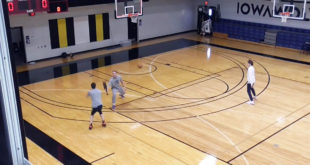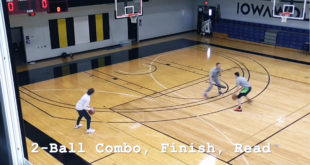There’s a plethora of training tools out there to choose from when you are putting together your year plan. One of my all time favorites is the weight vest, a great tool when your players are READY for them. Incorporating weight vests into your teams training can build toughness and prepare your players for the demands of the upcoming season. Like any training tool out there, it’s all about knowing when to use them, for how long, and making sure you have a specific goal to accomplish when using them. Just throwing a weight vest into your workouts for the sake of using a cool toy will lead to potential problems. When your body isn’t ready for weight vest training it will let you know in ways of soft tissue issues. Knee tendonitis, shin splints and low back tightness are all warning signs that you are training incorrectly.
Why To Implement Weight Vest Training?
- Improve team toughness.
- Increase overall conditioning.
- Improve overall power and explosiveness.
When You Should NOT Implement Weight Vest Training?
- Players aren’t strong nor conditioned enough to handle impact of ground forces the weight vest demands.
- Players have poor kinesthetic awareness and lack the coordination needed to move efficiently while wearing a weight vest.
- If your only goal is to “spice up” an exercise just for the sake of it with no overall plan.
What I will cover in this article is when to incorporate weight vest training in your workouts and the progressions involved. To maintain the brevity of this article I will focus on a jump circuit we do using the weight vest.
So, when is a good time to incorporate weight vests?
I like to use weight vests 3 different times of the year:
- Preseason workouts for team toughness drills and our Jump Circuit.
- In season for players with limited playing time to keep their competitive edge and conditioning.
- In the Spring with our work capacity phase.
A Needed Break
It’s August 20th and my guys are reporting in for training camp after 3 weeks of doing their “take home” workouts. Do I believe that most of them worked out during the 3 week break, yes. Do I also know that training at home in an old high school gym with your old high school buddies talking about the good ‘ol days isn’t the intensity that’s needed to prepare them for the upcoming season. Having said that I feel it’s extremely important to get a break once and awhile from the grind. I often shake my head when I hear of coaches that want their players to work solid through the off-season and not take any time off for themselves or to spend with family and friends. I’ve always believed that you’re going to get more out of your players if they have fresh legs and a positive mind rather than feeling as if they never had a break. The elusive balance of work and rest is hard to find, but it’s needed in my opinion.
The Base
My number one goal when I first get my guys back is to set the tone early and often. Hitting the reset button any chance I can get making sure they’re all on the same page. Counting together, working together, and getting better together is very important if you want to improve from the year before. I do this by putting them through a two week “get after it” phase that involves team building drills, toughness drills, as well as strength work. Within this phase we will also spend a lot of time on landing mechanics, body awareness, and jumping technique. From arm drive, knee bend, toe push-off, if it involves jumping or landing we will work on it. By revisiting these mechanics and coaching cues it helps my guys focus on the importance of quality jumping and landing. In turn giving me the confidence they will be able to handle the physical demands of the next phase. 4 week phase involving an increase in jumping, landing, and “moving like an athlete”. Like my good friend Joel Smith, strength coach for University of California Berkeley and in my opinion “Dr. Jump” often says, “if you want to jump higher, you have to practice jumping” and that’s what we will do, jump and a lot of it.
Next Step
I use a 4 week progression with the goal of slowly building up the volume of jumping, all the while maintaining perfect jumping and landing mechanics. It’s important to progress the players slowly, this allows your players bodies to adapt to the training demands. Hitting your players with too much volume too soon will lead to injuries or at least soft tissue issues. Quality is just as important, if 70% of the jumping they did during the workout was poor, you might as well just have them play “open gym”. You’re the coach so hold them accountable and to high expectations and lastly, like my good friend and amazing coach Robert Dos Remedios says, “tell them what you want to see, not what you don’t want to see”. This positive approach to coaching your players will do wonders with their jumping mechanics and their confidence. If you see a kid jumping and landing perfectly stop everyone and “spotlight” him or her, having everyone watch them do the drill perfectly will breed more perfect drills by other players. The more confident in jumping, feeling of improvement, the more enthusiasm will fill the air for following workouts to come. You always want your players leaving your muscle factory feeling better than they came in. The feeling of accomplishment is a powerful “buy in” in tool.
The Circuit (All Jump Circuits done with 20 lb. HumanX Weight Vest)
Low Level Jump Circuit-LL JC-5 seconds a set-Focus: Quick feet, limited ground contact, competition with teammate (how many reps of a given exercise can you get done in 5 seconds). Recovery time from this type of workout is fast less than 24 hours and it only last 5-8 minutes to complete. 1. Two foot hop 2. Hot feet 3. Speed squats 4. Knee Tucks 5. Butt Kicks 6. Lateral hops
High Level Jump Circuit-HL JC-15-30 seconds a set-Focus: Power, driving the body upward as high as possible rep after rep. Maintaining quality while fatigue set in. Recovery from this type of workout is a little slower 24-48 hours, it lasts about 8-12 minutes to complete. With increased demand on the body I like doing this jump circuit with a recovery day to follow.
- Box Jump
- Box Split Jump
- Bench Jumps
- Lateral Jumps
- Band Jumps
- Lunge Hops
- Plyo-Skaters
- 180 Jumps
Steady Progression
Week 1 Tuesday LL JC 2x Friday HL JC 1x
Week 2 Monday LL JC 3x Tuesday HL JC 1x Friday HL JC 1x Total 5 Sets
Week 3 Monday LL JC 3x Tuesday HL JC 2x Thursday LL JC 2x Friday HL JC 2x Total 9 Sets
Week 4 Monday LL JC 3x Tuesday HL JC 2x Thursday LL JC 3x Friday HL JC 2x Total 10 Sets
*Every player jumps differently and with a different rate of jumps per second so, it’s hard to know exactly how many jumps each player is getting in for each set. This gradual increase in the volume of sets and days jumping I’ve found is a safe progression.
Game Plan
Dynamic Warm-up 2 minutes Dynamic Stretch 5 minutes Movement Prep 2 minutes (jump circuit) 5 minutes Lift 50 minutes Foam Roll 5 minutes Static or Band Stretch Circuit 5 minutes Break and a Shake!
Method to the Madness
There’s a reason I like using two different jump circuits one being a low level day, and the other a high level day. This is because I feel it is easier to mirror those workouts to my lifts for the week, insuring built in recovery to each week. How do I do this? It’s easy, if the lift is quick and explosive our jump circuit will be the same. For example, if we have Jerks on the docket for our lift then the jump circuit will be low level, quick, limited ground contact circuit. On the other hand if the day calls for big band squats in our lift demanding more “loading” then the jump circuit will include bench jumps, which also involves more loading, more of a grind say 15 seconds of work compared to the fast 5 seconds of the low level circuit. Now these bench jumps should be explosive as well but, there will definitely be a dip in the power curve as fatigue sets in, that is when verbal coaching cues come into play, making sure quality doesn’t suffer. Mirroring the workouts helps train the body in specific energy systems, helps players with coach-ability and their mental prep because they know what the specific focus of the day is (grind out, or fast), and in my opinion improves recovery. On a side note I always start with our Jump Circuit after we finish the warm up, stretch, and movement prep. I do this because I feel it wakes up your players and really gets their CNS firing on all cylinders. This is also a great time to reinforce to them that it’s “winning” time. If you have a player noticeable not engaged and not ready to go, drop the hammer. I will often start the workout over or just tell the player to leave and come back when he or she wants to be part of the beautiful journey to getting better-ville. The mind needs to be right if you want your players to improve through the 4 week phase so, like I stated earlier hold them to that expectation.
Thanks for viewing, Create a Greatness and Go Cougs!
Scott Thom
 ScottThom.com Elite Basketball Strength Training & Player Development
ScottThom.com Elite Basketball Strength Training & Player Development



What weights are appropriate for High school players? 20 or 40?